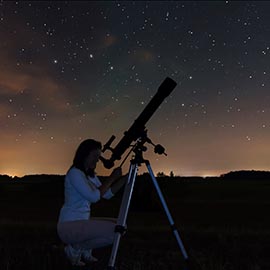DK Space: Space
When you look up at the night sky, the blackness you see is space. It is the great void, or emptiness, in which Earth, the Moon, the Sun, and the stars travel. Space is totally silent, and most of it is incredibly cold—around 454°F below zero (–270°C). It is also called outer space.
 From Earth, space begins at the outer edge of our planet’s atmosphere. There is no clear line between the atmosphere and space—the atmosphere gradually fades away until it merges into space about 300 miles (500 km) above Earth. However, there are tiny traces of atmosphere even farther out than this.
From Earth, space begins at the outer edge of our planet’s atmosphere. There is no clear line between the atmosphere and space—the atmosphere gradually fades away until it merges into space about 300 miles (500 km) above Earth. However, there are tiny traces of atmosphere even farther out than this.
Earth is a tiny speck of matter in space. It is one of nine planets that circle around the Sun. In turn, the Sun is one of several hundred billion stars, which together form a great star “island” in space called the Milky Way Galaxy. There are billions of galaxies in space. Together, all the galaxies and the enormous voids between them make up the Universe.
Astronomers believe that space is infinite—it has no edge or boundary. Earth’s nearest neighbor in space, the Moon, is 238,900 miles (384,400 km) away on average. The Sun is 90 million miles (150 million km) away. Most other stars in the Milky Way are between a million and a billion times more distant than the Sun. Other galaxies are millions of times farther still.
A light-year is a unit for measuring distances in space. It is the distance that light travels in a year—about 5.9 trillion miles (9.5 trillion km). Proxima Centauri is the closest star to the Sun. It lies about 4.2 light-years away from Earth, which means that its light takes 4.2 years to reach us.
Without a telescope, we can see about 2,500 stars on a really dark night. We often see the Moon, and sometimes the planets Mercury, Venus, Mars, Jupiter, and Saturn, as well as comets. The farthest thing we can see with just our eyes is the Andromeda Galaxy.
Table 1. SPACE TIMELINE
| AD 150 | Ptolemy claims Earth at center of Universe |
| 1543 | Copernicus puts Sun at center of Universe |
| 1609 | Galileo first to use a telescope to study space |
| 1687 | Newton publishes the laws of gravity |
| 1781 | Herschel discovers the planet Uranus |
| 1846 | Galle discovers the planet Neptune |
| 1926 | Goddard launches first liquid-fueled rocket |
| 1930 | Tombaugh discovers the planet Pluto |
| 1957 | First satellite, Sputnik 1, orbits Earth |
| 1961 | Yuri Gagarin becomes first person in space |
| 1965 | Mariner 4 sends back pictures of Mars |
| 1969 | Apollo 11 makes the first Moon landing |
| 1981 | First launch of space shuttle |
| 1990 | Launch of Hubble Space Telescope |
| 1998 | International Space Station construction begins |
